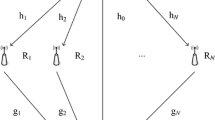Abstract
In this paper, a Ka-band satellite channel in deep space relaying networks is modelled based on propagation environments, considering weather impairments, shadowing, Doppler shift and solar scintillation together. The whole deep space channel is divided into three different parts based on the network architecture, which is a special case of the multi-state channel model applicable for a non-uniform propagation environment.




Similar content being viewed by others
References
O’Donnell, R. (2004). Deep space Ka-band link management and mars reconnaissance orbiter: Long-term weather statistics versus forecasting. Proceedings of the IEEE, 92(12), 1877–1878.
Wang, H., Hongchao, Y. (2008). Comprehensive Simulation and Hardware Implementation of Mobile Satellite Channel at Ka-band. In Millimeter Waves, 2008. GSMM 2008. Global Symposium on, Vol. 314–316, April 21–24 2008.
Liu, Y., Huang, G., & Zhen, S. (2004). Analysis of Ka-band satellite channel capacity in the presence of rain attenuation. In Microwave and Millimeter Wave Technology, 2004. ICMMT 4th International Conference on, Proceedings (pp. 175–177), 18–21 August 2004.
Perez-Fontan, F., Jeannin, N., Castanet, L., Mametsa, H.J., Lacoste, F., Hovinen, V., et al. (2011). Statistical and physical-statistical modeling of the land mobile satellite, LMS, channel at Ku- and Ka-band. Antennas and Propagation (EUCAP), Proceedings of the 5th European Conference on (pp. 3237–3241), 11–15 April 2011.
ITU-R. (2009). Propagation data and prediction methods required for the design of earth-space telecommunication systems. Recommendation ITU-R P.618-10, ITU Radiocommunication Bureau, Geneva, Switzerland.
Li, W., Law, C. L., Dubey, V. K., & Ong, J. T. (2001). Ka-band land mobile satellite channel model incorporating weather effects. Communications Letters, IEEE, 5(5), 194–196.
Garcia-Rubia, J. M., Riera, J. M., Garcia-del-Pino, P., & Benarroch, A. (2011). Propagation in the Ka Band: Experimental characterization for satellite applications. Antennas and Propagation Magazine, IEEE, 53(2), 65–76.
Evans, J. V. (1998). Prospects U.S. global satellite system operating at Ka-band. IEEE Aerospace Conference, 4, 525–537.
Rice, M., Slack, J., & Humpherys, B. (1996). K-band land-mobile satellite channel characterization. International Journal of Satellite Communications, 14, 283–296.
Li, W., Dubey, V. K., & Law, C. L. (2003). The performance of turbo coding over power-controlled fading channel in Ka-band LEO satellite systems. Vehicular Technology, IEEE Transactions on, 52(4), 1032–1043.
Sun, J. Gao, J. Shambayati, S. & Modiano, E. (2007). Ka-band link optimization with rate adaptation for Mars and lunar communications. International Journal of Satellite Communications and Networking, 25, 147–165.
Shambayati, S. (2003). On the use of W-band for deep space communications. IPN Progress Report 42–154, August 2003.
Filip, M., & Vilar, E. (1990). Optimum utilization of the channel capacity of a satellite link in the presence of amplitude scintillations and rain attenuation. IEEE Transactions on Communications, 38(11), 1958–1965.
ITU-R. (2005). Specific attenuation model for rain for use in prediction methods. Recommendation ITU-R P.838-3, ITU Radiocommunication Bureau, Geneva, Switzerland.
Garcia-Rubia, J. M., Riera, J. M., Benarroch, A., & Garcia-del-Pino, P. (2011). Estimation of rain attenuation from experimental drop size distributions. Antennas and Wireless Propagation Letters, IEEE, 10, 839–842.
Acknowledgments
The authors would like to gratefully acknowledge the project supported by the State 863 Projects (No. 2012AA121604).
Author information
Authors and Affiliations
Corresponding author
Rights and permissions
About this article
Cite this article
Xu, H., Zhou, X. Ka-band Satellite Channel Model in Deep Space Relaying Network. Wireless Pers Commun 77, 881–888 (2014). https://doi.org/10.1007/s11277-013-1541-x
Published:
Issue Date:
DOI: https://doi.org/10.1007/s11277-013-1541-x




